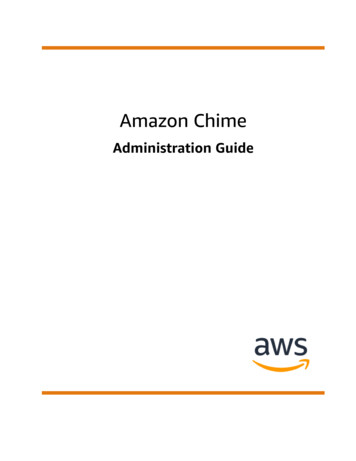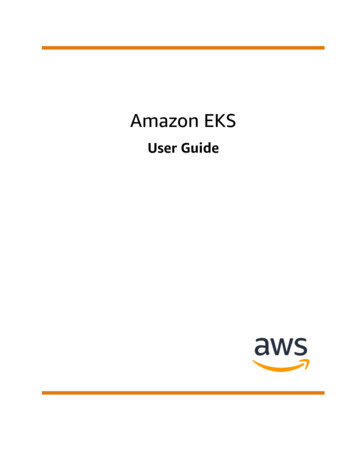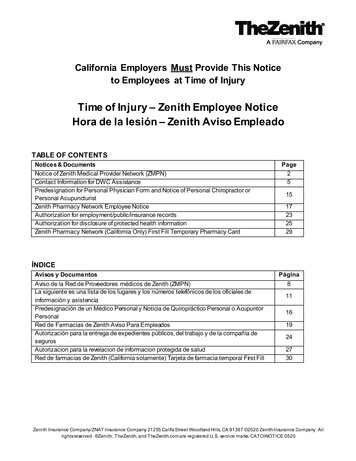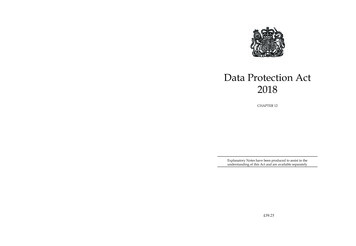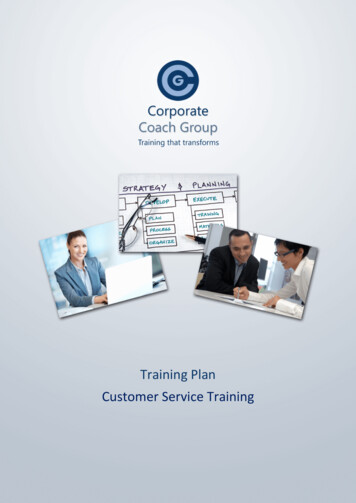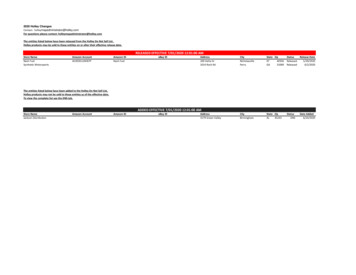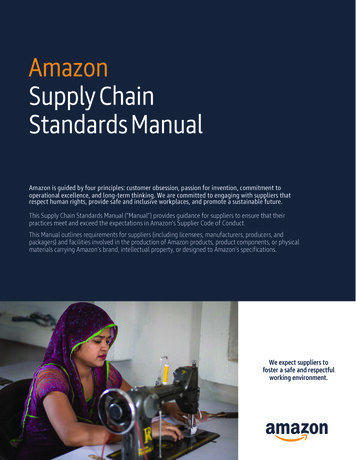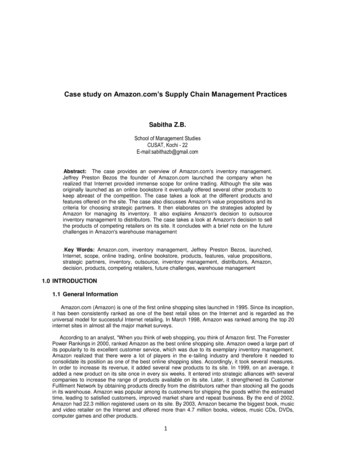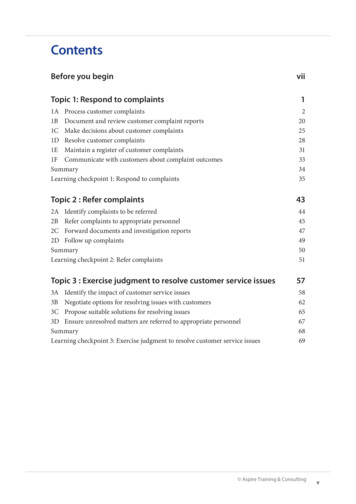
Transcription
ContentsBefore you begin viiTopic 1: Respond to complaints 11A Process customer complaints 1B Document and review customer complaint reports1C Make decisions about customer complaints1D Resolve customer complaints 1E Maintain a register of customer complaints1F Communicate with customers about complaint outcomes SummaryLearning checkpoint 1: Respond to complaints 220252831333435Topic 2 : Refer complaints 432A Identify complaints to be referred 2B Refer complaints to appropriate personnel 2C Forward documents and investigation reports 2D Follow up complaints SummaryLearning checkpoint 2: Refer complaints 444547495051Topic 3 : Exercise judgment to resolve customer service issues 573A Identify the impact of customer service issues 3B Negotiate options for resolving issues with customers 3C Propose suitable solutions for resolving issues 3D Ensure unresolved matters are referred to appropriate personnel SummaryLearning checkpoint 3: Exercise judgment to resolve customer service issues 586265676869 Aspire Training & Consultingv
BSBCMM301Process customer complaints continuedJetson’s Baths – Refund and exchange policyChange of mindIf you are not fully satisfied with your new Jetson’s product, simply return it to the store whereit was purchased, along with your receipt, within 14 days.We will happily provide an exchange or refund, providing the product is in new condition.This means that the packaging has not been damaged and the product has not been used ordamaged.When providing a refund: If the product was purchased by cash, we will provide a cash refund. If the product was purchased on a credit or EFTPOS card, we will credit the account with therefunded amount.Please note that we are unable to offer ‘change of mind’ returns on custom-made items, suchas monogrammed bath robes.We do not cover the cost of return postage for ‘change of mind’ returns.Faulty productsWe will arrange a repair, refund or replacement for faulty or incorrect items in accordance withAustralian Consumer Law.We will reimburse the cost of return postage for faulty items and incorrect deliveries.Thank you for reading these conditions and for your understanding. We hope to provide the bestpossible service to you, so please let us know if you have any questions or concerns.Complaints from external customersExternal customers are people from outside an organisation who interact with it, whetherthis is regularly, occasionally or even just once. They include clients who purchase productsor services, suppliers who provide specific products or services, consultants, contractors andpeople from other businesses or agencies.Complaints received from external customers may range from minor dissatisfaction with aservice (‘I had to wait two hours for my sofa to be delivered’) to a major complaint regardingthe organisation that could have serious consequences (‘I’m going to sue your company forselling me that children’s swing – it’s dangerous and its poor quality shows your blatantdisregard for my child’s safety’).External complaints commonly relate to: incorrect advertising inaccurate information rude employees faulty products inadequate service.4 Aspire Training & Consulting
BSBCMM301Process customer complaintsBe clear about the following areas of responsibility.Complaints you are responsible for Be familiar with the types of complaints you are responsible forhandling. For example, you may be responsible for correctingadministrative errors, following up delivery mistakes, replacing damagedgoods, or preparing and sending acknowledgment letters.Complaints you are not responsible for Know the type of complaints that need an expert or someone moresenior in the organisation to resolve. Examples are serious complaintsrelating to discrimination, safety or privacy and complaints relating to aspecific product. Also know who to refer a complaint to if it is outside your area ofresponsibility or is a serious matter; for example, you may need to refera complaint to a manager, a colleague with expertise in the area or amanufacturer.Deal with a complaintUnderstand what procedures have to be followed. Usespecific communication strategies such as active listening,empathising and asking follow-up questions to clarify thesituation. There may be formal procedures to follow, suchas completing a complaint record.Many of the complaints received will relate to theorganisation’s products and services. The more staffknow about these, the easier it will be for them to provideexplanations to customers and to follow up complaints.Legislative and organisational requirementsAll interactions with customers must be conducted in accordance with legislativerequirements and company policies on maintaining privacy, not being discriminatory andcomplying with consumer and trade practices Acts. An organisation’s compliance-relatedpolicies and procedures should be developed in accordance with relevant Acts. Complaintsrelating to breaches of these Acts may result in legal action.Even though staff members don’t need to memorise all the Acts, they must understand theessence of the legislation and how it may relate to the complaints they receive.6 Aspire Training & Consulting
BSBCMM301Process customer complaintsConsumer rightsAustralian Consumer LawAustralian Consumer Law is the overall name for the various state and territory lawsthat protect consumers.When processing customer complaints, you must follow the rules set out inlegislation about when customers are entitled to a refund, repair, exchange orcompensation.You must also make sure not to mislead customers.Codes of practiceDepending on the industry sector you work in, you may also be required to followspecific standards or codes of practice when dealing with customer complaints. Forexample, there are codes of practice that relate to complaints about advertising,insurance, lotteries and service delivery by government departments.These codes are voluntary (not required by law) so you need to know which codes orstandards your organisation has made a commitment to comply with.Work health and safety (WHS)Work Health and Safety Act 2011 (Cth)This Act exists to make sure that all employees and others are safe at work.Employers and employees have a responsibility to keep the workplace safe. Thismeans following safe work procedures, and reporting and removing risks andhazards.The law also protects people’s psychological safety by making bullying andharassment illegal and recognising that stress is a WHS issue.Process customer complaintsDifferent types of complaints warrant different formalities and procedures. A complaintabout a faulty product could be handled by the customer service manager and/or the qualitycontrol officer. A complaint about a workplace hazard could be handled by the WHS officerand the property manager.Processing complaints is about the actions taken towards resolving a problem. Efficient andsuccessful handling of complaints is a very important aspect of quality customer service.Here is information about the customer complaints process.Customer complaints process Identify the nature of the complaint. Document the complaint. Investigate the complaint. Negotiate a solution. Follow up with the customer.8 Aspire Training & Consulting
BSBCMM301Process customer complaintsBe politeAlways be polite when handling a customer complaint. If you lose your temper orbehave rudely, you will inflame the situation and make the customer angrier. Partof being polite and courteous is the ability to remain calm, regardless of how thecustomer behaves. Don’t let difficult customers upset you.Your customers come from a diverse range of social, cultural and ethnic backgrounds.They may have physical or mental disabilities or be unwell. They may be drug affectedor emotionally distressed. These factors may affect the way they behave, speak ornegotiate.Treat all customers with respect and tolerance. If you are friendly and courteous tothe customer, this helps build rapport and trust, which will be an advantage whenprocessing their complaint.Customers find it more difficult to yell at a friendly customer service person than aperson who is abrupt, rude or unsympathetic.Be calmDon’t become defensive when you receive a complaint and don’t take the matterpersonally. It is human nature to want to make excuses or blame someone else whenfaced with someone complaining. But be objective, stay calm and put yourself in thecustomer’s shoes. They are angry at something that has happened, not at you. Your jobis to fix the problem for them, not to lay the blame.Responsibility for the problem will be established later, when the complaint is analysedinternally.Communicate appropriatelyYou can communicate with customers in a range of ways. Choose the most efficient wayto handle a complaint according to the nature of the complaint and the customer you’redealing with.The following describes communication methods and examples of when they could be used.TelephoneIf the customer is from interstate or they need to knowsomething urgently, a telephone call may be appropriate.12 Aspire Training & Consulting
BSBCMM301Process customer complaintsUse active listening skills. This kind of listening requires you to concentrate on what theperson is saying. For example, you can repeat things back to the customer to check you haveheard correctly. You can also ask questions to clarify what has happened and why they areupset. Give the customer the opportunity to confirm their request.Let the customer know you are listening in these ways.If you are face to face with them, they will know you arelistening by the way you nod or smile. Make sure you useeye contact.Don’t interrupt the customer or complete their sentencesfor them. This is rude and can also cause you to miss someof what they are saying.Remember to take notes when a customer is explainingthe details of their complaint to you. Your notes will helpyou remember the important points of the complaint andwill serve as a record of the conversation.Consider your customersWhen dealing with customer complaints, be aware of the person’s age, sex, religion, cultureand experience. Use language that is suitable, based on what you see and hear. Ask theperson how they prefer to be addressed (John, Mr Smith). Talk with people in ways that arebest for them.If you are going to have an extended interaction with someone – such as dealing witha complaint relating to complex or personal matters – you may need specialist help tofacilitate communication.Be mindful of cultural factors such as the following: Some types of nonverbal communication (body language), like looking someone in theeye, are seen as positive in some cultures, negative in others. There may be a protocol about who you should communicate with; for example, in somecultures you need to deal with the senior male family member. A person may not speak English well enough to discuss legal, medical or financialmatters, even if they appear to be fluent in general conversation.Speak clearly and avoid jargonAlways speak clearly and in a pleasant tone to customers.When you are talking to a customer, the way you speaksets the tone of the conversation. This is particularly trueof telephone conversations. You should sound concerned,informed, empathetic, patient and pleasant. A boredsounding customer service officer can be infuriating to analready angry customer.Focus on the conversation and make sure you arespeaking clearly and at a volume and speed that thecustomer can comprehend. If you have a naturally quiet voice or feel shy about talking topeople, you need to practise your verbal communication skills. Ask a confident friend orcolleague to coach you.14 Aspire Training & Consulting
BSBCMM301Process customer complaintsIf you have an open stance and a friendly, concerned look on your face, this will help thecustomer feel their complaint is being taken seriously. Try not to fold your arms, as this canlook confrontational.You can read how the customer is feeling by their body language too. If they are punchingthe desk, going red in the face or pointing a finger at you, you know they are furious. If thecustomer is calm and still, they are probably going to be easier to deal with. Look out forthese signs and try to gauge how the customer is feeling from their body language.Review your performancePart of your responsibility at this level is to manage your own performance by regularlymonitoring and evaluating it. How well are you following organisational policies andprocedures, communicating with customers and processing complaints?It is your job to keep up to date with changes and feedback. For example: Complaints procedures may change. New products and services may be introduced. New legislation relating to consumer protection may be introduced. Customer feedback may indicate there is dissatisfaction with the way you have handledand resolved a complaint.You should seek out learning opportunities to improve your performance.Review your performance on a regular basis: Analyse a situation that you handled successfully – what techniques did you use andhow could you generalise this experience? Check your knowledge of legislation, the organisation’s products and services, andorganisational procedures. Review your written and verbal communication – do you need to improve yourgrammar and spelling, or could your telephone manner be clearer? Ask a colleague or your supervisor to comment on your performance. Check the feedback forms filled in by customers you have dealt with. Discuss your work at a formal performance appraisal session with your manager.Seek learning opportunitiesPart of managing your performance is taking responsibility for seeking learningopportunities whenever you can. For example, if you have identified that your listeningskills could be improved, think of ways to seek help or advice in this area.Here is more about learning opportunities.Learning opportunities Asking to be coached Arranging to have a mentor Asking questions at team meetings Observing an experienced person interacting with customers Reading business journals, books and blogs Applying for a course that relates to a training need16 Aspire Training & Consulting
BSBCMM301Process customer complaints continued got your order in front of me now, Mrs King. The mix-up seems to be that on theI’veorder form you faxed us, the box for general garden maintenance was ticked. Thisincludes weeding and pruning. How would you like us to deal with this?Mrs King: Oh dear, I must have ticked the wrong box. Well, I guess next time I just want thelawns mowed.Becky: Certainly, Mrs King. I will change the records and let Janelle, the gardener, know. Isthere anything else I can do for you today?Mrs King:That’s all, thank you.Practice task 1Read the scenario, then answer the questions that follow.ScenarioYou work as a receptionist in a marketing agency. An unhappy client phones to say they arewaiting on a statistics report that is well overdue. You contact the account manager for thatclient, Rika, and refer the matter to her. You provide her with all the details of the complaint.Rika then goes to Geoff, who is in charge of preparing the statistics report. He works part time,so she can’t speak to him until the next morning.Geoff says he is waiting on information from the research department in order to compilethe report. He calls the research department in London, a different time zone, and leaves amessage to ask when the information will be sent.Meanwhile, the client has been waiting 24 hours since the initial contact. He phones you againand asks why no-one has got back to him.1. What has gone wrong in this situation?continued 18 Aspire Training & Consulting
Topic 1Respond to complaintsSome organisations have separate forms for different complaints; for example, anorganisation may have one form for customer service complaints and another form forcomplaints relating to products and services. Other organisations have the one form forall types of complaints. Some organisations may require you to document the complaintsyourself, using your own form or system.Supporting evidenceAll documentation relating to a complaint must be collected, stored and made easilyaccessible. If there is confidential material, you may need to store this in a locked cabinetor password-protected database. Because much of the supporting evidence may not becomputer based, you should probably prepare a manila folder to store the information.Documentation should be backed up – electronic files should be copied to a back-up serverand paper files should be copied and held at a separate location.What the folder may contain Completed feedback form Internal reports Correspondence – notes, letters, emails, faxes Photographs Affidavits, statutory declarations and witness statements Medical reports Audio or video recordings of telephone calls or meetings Delivery slips, invoices, receipts, contractsReportsYou may be required to write a report about the complaint. Your manager may require a fullreport if the customer decides to take legal action. If a customer telephones your supervisorto ask what has been done about their complaint, your report will be evidence of the actionyou have taken. Therefore, your supervisor will want a comprehensive report that includesthe form you initially filled in.Use your written communication skills to present the information in an honest,straightforward, unbiased way. Remember to use plain English. You may need to attachsupporting documentation to your report.A complaint report may contain: A summary of the complaint The measures taken to solve the problem Who was involved The outcome of the complaint Aspire Training & Consulting21
BSBCMM301Process customer complaintsFaulty items If the item was faulty or damaged when the customerpurchased or received it, they are entitled to a repair, refund,exchange, replacement or compensation under AustralianConsumer Law. If you are not authorised to handle returns, ask yoursupervisor or manager to deal with the complaint. You may need to organise pick-up of the faulty item anddelivery of a replacement. Log the matter according to your organisation’s returnsprocedure.Refunds and credit Australian Consumer Law does not require organisationsto give a refund or exchange for ‘change of mind’, but someorganisations offer this as part of their customer servicestrategy. You need to check your organisation’s policies to ascertainwhether a refund or credit is allowed. It is always a good ideato check with a manager before providing a refund or credit. Log the matter according to your organisation’s returnsprocedure.Practice task 3Read the case study, then answer the questions that follow.Case studySanji works in a garage. Mr Lando, a customer, comes in with a serious complaint. Mr Lando isangry because Sanji’s boss told him last week that the brakes on his car were fixed and safe.But Mr Lando says that when he was driving home, the brakes were not working properly andthis caused him to rear-end another car. No-one was hurt, but both cars were damaged. MrLando tells Sanji that he blames the garage for the accident.Sanji feels that if he apologises to Mr Lando, he will get into trouble for admitting fault beforethere has been an investigation. Sanji knows that this complaint is too serious for him tohandle. He listens carefully and writes down Mr Lando’s details and the complaint details. Hetells Mr Lando he will ask the boss to contact him as soon as possible.After Mr Lando leaves, Sanji makes a paper file for his boss. In it he places Mr Lando’s details,the details of the complaint and a print-out of the history of Mr Lando’s car repairs. Then Sanjirings his boss and tells him to come to the garage straight away.continued 26 Aspire Training & Consulting
Topic 1Respond to complaintsSteps to resolve customer complaintsThe following flow chart illustrates the steps you should take when negotiating andresolving customer complaints.Apologise for any inconvenience caused.Ask the customer what sort of solution they would like.Offer solution/s to the problem promptly.Seek prompt advice if you are unable tooffer a solution the customer is happy with.Explain the solution clearly.Make sure the customer understands exactly what you are offering.Check that the customer is happy and satisfied with the offer.Reassure the customer that the action you have agreed on will be carriedout immediately (if possible and appropriate).Reassure the customer that steps will be taken to ensure this problem doesnot occur again.Ask the customer if there is anything else you can do for them.Thank the customer for bringing the problem to your attention. Aspire Training & Consulting29
Topic 1Respond to complaints1EMaintain a register of customer complaintsIt is a good idea to maintain a register of customer complaints because they contain valuableand important information for the organisation, including the following:The complaintA record detailing a complaint and the steps taken to process the complaint providesa reference allowing anyone in your organisation to see what happened. Your managermay want to read your documented complaint to learn what happened and how youdealt with the situation. A colleague may receive the same complaint you received andwish to refer to your documents to find out how you dealt with it.ProofYou may be required to prove that you took action following a customer complaint. Forexample, a customer may say nothing was done after they made a complaint to you. Ifyou have a record stating the actions taken following the complaint and the date theactions were taken, it is easier to prove your competence as a customer service officer.You may also need a record of the customer’s details for future reference.Some disputes involve a lot of discussion, correspondence and supporting evidencesuch as invoices and copies of policies that must be filed with the original complaintform. Such documents need to be provided if the complaint is serious and is referredto an external organisation such as the police, an ombudsman, a lawyer or a consumeraffairs organisation.LearningComplaints provide an opportunity to improve an organisation’s service. Reviewingcomplaints is something you, your colleagues and your manager can do to ensure thatsituations leading to complaints are not repeated. Reviewing complaints is also anopportunity to rectify any outstanding problems.The organisation may track the nature of complaints over a period of time to learn how,when and why they occur. The register of complaint documents should be regularlymaintained. This allows for ongoing review.If you deal with a complaint by putting ‘a patch’ on the problem, the same complaintmay keep occurring. For example, if a customer complains that a salesperson wasrude and you give the customer a complimentary product to apologise, this solves theimmediate problem of the angry customer; however, if the salesperson concerned isnot spoken to, these complaints may continue. Aspire Training & Consulting31
Topic 1Respond to complaints1FCommunicate with customers aboutcomplaint outcomesAlways let customers know about the outcome of aninvestigation into their complaint. If the customer hasno idea what you have done or are doing about theircomplaint, they are likely to become angrier or morefrustrated and make further complaints.Some complaints may be particularly complex and theinvestigation process may be long. By the time you cometo the end of it, you may forget to tell the customer.You need to tell them briefly what was involved in theinvestigation process, the outcome of the complaint andthe justification behind the outcome.Practice task 6Read the case study, then answer the questions that follow.Case studyClaire works in a travel agency. She deals with many clients every day and every client hasspecific requirements that she needs to meet.Claire is organising a holiday for Miss O’Neill, who has a habit of making last-minute bookings.However, because she is a good customer, Claire always goes the extra mile to help her. MissO’Neill wants to fly to Cairns on 3 July, arrive mid-morning, then travel by bus to Port Douglasand stay at a resort for five nights. Miss O’Neill has a wedding to attend on 4 July in PortDouglas, so she wants to get there the day before to settle in.Claire then checks the flights and finds that the only available flight that will get Miss O’Neill toPort Douglas on 3 July has her landing in Cairns at 10.00 pm. She books this flight anyway. Shealso books airport transfers and accommodation.Claire then faxes Miss O’Neill an itinerary, but forgets to explain the situation with the flights.Miss O’Neill rings the travel agency in a very bad mood.‘I told you I wanted to arrive mid-morning on 3 July!’ she yells at Claire.Claire explains that there was nothing else available. She tells Miss O’Neill that she will let herknow if a seat becomes available on any other flights. Claire calls around for any cancellations.On her third try, she finds a seat on a flight arriving in Cairns at 10.00 am on 3 July. ‘Perfect!’she thinks.Claire cancels the original flight booked for Miss O’Neill. She has found a flight that arrives midmorning and she has booked a lovely resort for Miss O’Neill. She feels proud of herself.At the end of the day on 3 July, Claire gets a call from Miss O’Neill, who is at the airport. She isfurious. She thinks she is booked on a 6.00 pm flight to Cairns, but the airline has no recordof her booking. Claire realises her terrible mistake in not letting Miss O’Neill know about thechange of flight.continued Aspire Training & Consulting33
Topic 1Respond to complaintsCommunication skillStrategyPart BRead the two scenarios, then complete the tasks that follow.Scenario 1Your manager complains to you that a report he asked you to complete is overdue. He is due topresent this report to an important client at an interstate meeting in three days and would liketime to review and edit the report before the meeting.You tell your manager that you have completed your section, but the report needs someresearch results that you are waiting on from the sales department. A week has gone by andthey have not supplied you with the data, even though you have telephoned and emailed theresponsible person three times.Your manager reminds you that you must always inform him if any difficulties arise that maycause you to miss a deadline.Scenario 2A customer has been told that some car seat covers sold by your company are ideal for stationwagons. Later, he phones your organisation and says, ‘I was given incorrect advice that hascost me a lot of time and inconvenience’.The customer says that the sales assistant who served him did not tell him that the seat coverswould only fit certain models. The seat covers he purchased do not fit his station wagon.The seat covers in your shop are clearly labelled – with shelving signs and on the packaging –stating which models they fit.For each scenario, describe in one page how you would handle this complaint from start tofinish. Make sure to cover: the communication strategies, including the communication medium, you would use the policies or legislation you would have to comply with the documents you would gather and prepare as part of the complaintsresolution process how you would negotiate with the other person to resolve the situation and ensure theywere satisfied with the outcome how they would be informed of the outcome how the complaint-handling process could be improved. Aspire Training & Consulting39
BSBCMM301Process customer complaints2AIdentify complaints to be referredTo decide on the appropriate person to handle a complaint, you need to work out the natureof the complaint and determine its seriousness. Think about the issues the complaint raises.Are they issues you know how to handle? Are they issues you are allowed to handle?Also refer to your organisation’s policies and procedures when deciding who should handlecomplaints.Refer complaints to othersDifferent people are authorised to handle differentcomplaints. These include WHS officers, specialistworkers, managers, police, ombudsmen, stateand territory consumer affairs bodies, andthe Australian Competition and ConsumerCommission (ACCC).If the complaint is straightforward and you areauthorised to handle it, you do not need to referthe complaint. However, if the issue is a matter youare unauthorised to handle or you do not have theknowledge or expertise needed, refer it to someonemore appropriate. For example, if a customercomplains that they are having trouble using aproduct because the instructions are not clear, you could refer them to a specialist whoknows the product well.When a complaint involves an allegation of legal infringement, such as sexual harassment orsome form of discrimination, an external body such as the police or the Australian HumanRights Commission may become involved.v1608For a serious complaint, check your organisation’s procedures so you know who to refer thematter to. You may need to refer the matter to a senior manager. You may need to make anappointment with them, prepare a written summary and gather all the existing information(such as complaint letters and other documents) for them. Your manager may give youinstructions as to how to proceed.44 Aspire Training & Consulting
Topic 2Refer complaints2DFollow up complaintsAfter you refer a complaint to someone else, this does not mean the complaint is out of yourhands. You still have a responsibility to ensure the complaint is processed and a solution isnegotiated and communicated with the customer.If you refer a complaint to another employee by email, speak to that employee to confirmwhether they received the email. After an appropriate length of time, ask them whethera sol
matters, even if they appear to be fluent in general conversation. Speak clearly and avoid jargon: Always speak clearly and in a pleasant tone to customers. When you are talking to a customer, the way you speak : sets the tone of the conversation. This is particularly true
